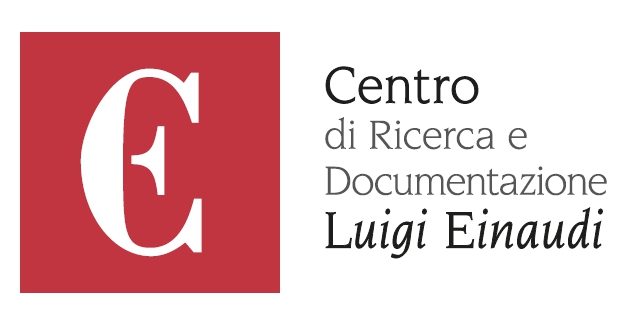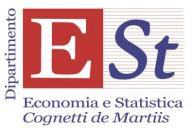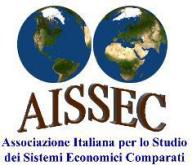Maurizio Bussolo - The World Bank[1]
Abstract[2]
This short paper discusses the evolving perspectives on economic inequality over the past decade and examines potential future developments in this field of research. Initially, economic inequality was mainly analyzed through the perspectives of market efficiency and individual responsibility. Economists predominantly highlighted the role of free markets in fostering growth and prosperity, often overlooking distributional issues. However, a notable shift has occurred in the economic discourse on inequality, and the focus has increasingly turned towards inclusive growth, and the fact that high inequality can undermine economic and social progress. In the last decade, four primary themes have been explored and the new research has intensified this shift: (i) the assessment of levels and trends of inequality of outcomes and inequality of opportunities, (ii) the multifaceted impacts of inequality, (iii) global inequality, and (iv) the political economy of inequality. Future research trajectories will be shaped by interdisciplinary collaboration, technological advances, and the exigent challenges posed by climate change and global disruptions.
1. Introduction: some recent influential work on inequality
Economic inequality, defined as the unequal distribution of income and wealth among individuals and groups within a society, has been a persistent issue throughout history. In the recent decade, the study of economic inequality has gained renewed importance, as economists and policymakers recognize its far-reaching implications for social and economic progress. In his 2013 State of the Union address, President Barack Obama emphasized that while the economy was recovering, the benefits were not being evenly distributed. He stated that “Inequality is the defining challenge of our time.” This note explores the evolving perspectives on economic inequality over the past decade and examines potential developments for the next decade.
Initially, economic inequality was often viewed through the lens of market efficiency and individual responsibility. Traditional economic theories emphasized the role of free markets in promoting growth and prosperity, with less attention given to the distributional outcomes. A significant shift in the way economists approach the issue of economic inequality has intensified in the past decade. The focus has increasingly turned towards inclusive growth, recognizing that high levels of inequality can undermine economic stability and social cohesion. Prominent monographs on these topics, all published in the last 10 (or so) years, include (in order of the time of publication): Stiglitz (2012), Deaton (2013), Piketty (2014), Atkinson (2015), Milanovic (2016), Saez and Zucman (2019) and Chetty’s several papers on intergenerational mobility such as Chetty et al. (2014) and Chetty et al. (2017). These influential studies have profoundly shaped the understanding of economic inequality, highlighting its complex nature and the need for comprehensive long-term solutions. They emphasize the detrimental effects of inequality on growth, health, and social cohesion, the concentration of wealth, the importance of historical and global perspectives, the critical role of circumstances in shaping the unfair process behind inequality, and the call for various redistributive policies. These themes are discussed in more details in the next section. A look at the possible future evolution of the thinking on inequality follows in a concluding section.
2. Four main themes of the recent research on inequality
Let’s consider some of the themes highlighted by these studies in more detail. Four main themes are briefly discussed: 1) the assessment of the levels and trends of inequality of outcomes and inequality of opportunities, 2) the multifaceted impact(s) of inequality; 3) global inequality; 4) the political economy of inequality.
2.1. Inequality of outcomes and inequality of opportunities
Assessing the levels and trends of inequality of outcomes, essentially incomes and wealth, remains a central focus of economic research and policy discussions. International organizations such as the International Monetary Fund (IMF) and the World Bank have also taken a more active role in addressing inequality. In particular, the World Bank has adopted a new corporate scorecard: the number of countries with a Gini coefficient greater than 40 (a high level of inequality). This indicates a sharp focus of the World Bank towards a reduction of the number of countries affected by high inequality. This focus is welcome; however, challenges remain.
There is a consensus on the importance of addressing income and wealth inequality, yet considerable uncertainty remains on its precise level. This uncertainty is less pronounced when it comes to trends over time. The study “Inequality Bands: Seventy-five years of measuring income inequality in Latin America” by Alvaredo, Bourguignon, Ferreira, and Lustig (Alvaredo et al., 2024), sheds light on this issue. Accurately measuring the incomes of the wealthy poses significant challenges that can lead to discrepancies in inequality estimates. The incomes of the rich are often underreported or difficult to capture through traditional survey methods. In addition, ensuring consistency with national accounts is crucial to obtaining reliable estimates of income distribution.
In terms of measuring top incomes, an often-used approach to use tax records data. The World Inequality Lab at the Paris School of Economics extensively uses these data to analyze income distribution. However, there are several issues with this approach, such as the availability and reliability of tax data in different countries. As an alternative, researchers have explored using house prices as a predictor of household incomes. For example, Van der Weide et al. (2018) demonstrated that using house prices can provide a more accurate estimate of household incomes. The motivation for using alternative approaches, such as house prices, is that tax data may not be available or reliable for many countries. These alternative methods can help provide a more comprehensive picture of income inequality, especially in contexts where traditional data sources are limited.
In addition to the inequality of outcomes, the concept of inequality of opportunity has gained prominence in recent years. Inequality of opportunity refers to the idea that the outcomes people achieve in life—such as incomes, education, and wealth—should not be determined by circumstances beyond their control or those they cannot choose; see Roemer (1993), Fleurbaey (1994), and Ferreira and Peragine (2013). The principle of equality of opportunity asserts that individuals should have an equal chance to succeed, regardless of their background or circumstances. This concept is fundamental to the notion of a fair and just society. It emphasizes that factors such as birthplace, parental background, and other circumstances should not dictate an individual’s life outcomes. To better understand and address inequality of opportunity, various measurement initiatives have been developed. One notable initiative is the Global Estimates of Opportunity and Mobility (GEOM), which provides comprehensive data on intergenerational mobility and equality of opportunity across countries. The GEOM database, accessible at www.geom.ecineq.org, offers valuable insights into the extent to which individuals’ outcomes are influenced by their circumstances.
By focusing on both inequality of outcomes and inequality of opportunities, researchers and policymakers can develop more effective strategies to address the root causes of inequality and promote social mobility.
2.2. Impact(s) of inequality
Recent research has highlighted the critical nature of inequality and its potential to hinder economic growth, lower the effectiveness of growth in poverty reduction, undermine social cohesion and mobility, and exacerbate insecurity and the crisis of the middle class.
For example, Radhicka Kapoor from the Indian Council for Research on International Economic Relations recently argued that "Gender inequality has become macro-critical." This perspective is significant because it recognizes inequality as a potential obstacle to economic growth, challenging the traditional view of a trade-off between equity and growth. The presence of inequality of opportunity and misallocations have been the main arguments used to demonstrate the detrimental impact of inequality on growth. When people perceive that their efforts will not lead to improved outcomes due to systemic barriers, their motivation to strive for better opportunities diminishes. This is shown in studies such as Ferreira et al. (2017) even if pinpointing the exact mechanisms and causality at the micro level remains challenging, as shown in studies like Brock and Bussolo (2023) and Card et al. (2012). Similarly, when resources are not allocated efficiently due to inequality, economic growth can be stunted. Hsieh et al. (2019) and Marrero and Rodríguez (2013) highlight how inequality can lead to suboptimal investment and utilization of resources, ultimately hindering economic progress.
Higher levels of inequality can reduce the effectiveness of economic growth in alleviating poverty. When inequality is high, the benefits of growth are not distributed evenly, resulting in less significant reductions in poverty. This relationship is discussed in Bourguignon (2003), which shows that with higher inequality, growth has a diminished impact on poverty reduction.
Inequality can undermine social cohesion and limit social mobility. The Great Gatsby curve illustrates the relationship between inequality and intergenerational mobility, showing that higher inequality is associated with lower mobility. This concept is well presented in a survey paper by Corak (2013).[3] When inequality is high, individuals from disadvantaged backgrounds face greater barriers to improving their socioeconomic status, leading to a less cohesive society.
Finally, inequality can contribute to a sense of insecurity and a crisis within the middle class. Recent studies have shown that economic insecurity has increased in European countries in the last decade. One study Bussolo et al. (2025) uses panel data to analyze income levels associated with a given probability of falling into poverty. A low probability of falling into poverty is used as a novel definition of being in the middle class. The findings indicate that, at any given income level, insecurity (i.e., vulnerability to falling into poverty) has increased in the last ten years. This suggests that there is a crisis of the middle class, as more individuals face the risk of economic instability despite their income levels. This growing insecurity among the middle class is a critical issue, as it can lead to decreased consumer confidence, reduced spending, and overall economic instability. Addressing this crisis requires targeted policies to improve economic security and support the middle class.
2.3. Global inequality
Global inequality is a critical issue that has significant implications for both economic and social dimensions worldwide. Understanding why global inequality matters involves exploring two sets of arguments: the impact of globalization and the relevance of social welfare theories. Globalization has led to increased interconnectedness and awareness of income disparities across countries. Even in the absence of a global government, globalization facilitates the flow of information, making people more aware of the income levels and living standards of others around the world. This heightened awareness can influence perceptions of fairness and equity, leading to demands for a more equitable distribution of resources at the global level.
Theories of justice provide a framework for understanding the ethical implications of global inequality. The first theory, utilitarianism, posits that social welfare is the sum of individual utilities. According to this theory, at a given mean income, social welfare decreases with increasing inequality due to the principle of decreasing marginal utility of income. Therefore, reducing inequality can enhance overall social welfare by increasing the utility of those with lower incomes.
The second theory, Rawlsian justice, and particularly the concept of “Global Rawlsianism”, emphasizes the importance of addressing inequalities that arise from circumstances beyond an individual’s control, such as place of birth. Rawlsian justice argues for a fair distribution of resources to ensure that individuals have equal opportunities, regardless of their birthplace.
2.4. Political economy of inequality
In democratic societies, there are political mechanisms that should inhibit or reverse large increases in inequality. One of the central models in political economy, originally proposed by Meltzer and Richard (1981), suggests that high inequality in a democracy should lead the politically powerful (in their model, the voter at the median of the income distribution) to vote for higher levels of taxes and redistribution. This increased taxation and redistribution would partially offset the increasing inequality. However, there are several issues with this model as discussed in some recent research.
The first issue is that of divergent views on what inequality is. Perceptions of inequality can differ significantly from the definitions and assessments of the academic research in economics. Alesina (2004) show that while inequality, as measured by the Gini coefficient, is higher in the US compared to the EU, redistribution is higher in the EU than in the US. This discrepancy highlights the role of perceptions of inequality in shaping policy preferences. Gimpelson and Treisman (2018) discuss the misperceptions of inequality, while Bussolo et al. (2021) examine how perceptions of inequality are formed. These studies suggest that individuals’ views on the nature and levels of inequality can influence their support for redistribution policies.
The second issue with the Meltzer-Richard model is the distinction between de jure (legal) and de facto (actual) control over government policies and institutions. Acemoglu and Robinson (2013) have developed this concept further, showing that even in democracies, the actual control over policy decisions may not rest with the median voter. Instead, powerful interest groups or elites can exert significant influence over government policies, thereby limiting the extent of redistribution and perpetuating inequality.
Finally, informal systems of redistribution and insurance play a crucial role in mitigating inequality in many societies. These systems include family networks, community support, and other non-state mechanisms that provide a safety net for individuals. However, these systems can also perpetuate certain social norms and inequalities. For example, in some South Asian societies, the social norm of patrilocality, where women move to live with their in-laws after marriage, can be detrimental to gender equality. Women lose their networks and find it harder to work, limiting their economic opportunities. However, this norm also serves as a form of informal insurance, as the extended family provides support and security (Rosenzweig and Stark, 1989). Informal redistribution can also occur through the provision of group-specific public goods. Bussolo and Dixit (2023) discuss how these goods, tailored to specific communities or groups, can serve as a form of informal redistribution, addressing the needs of particular segments of the population. Finally, the presence of a large informal sector can affect the impact of consumption (indirect) taxes. Bachas et al. (2024) discuss how these taxes, which are typically considered regressive, may have different effects in economies with significant informal segments. In such contexts, the standard regressive impact may be mitigated or altered due to the unique dynamics of the informal economy.
In summary, while the Meltzer-Richard model provides a foundational framework for understanding the political economy of inequality, several factors complicate its application in real-world democracies. Recent research showed how divergent views on inequality, the distinction between de jure and de facto control, informal systems of redistribution, and the persistence of gender inequality all play crucial roles in shaping the political responses to inequality.
3. The future of inequality studies
As we look to the future, the study of inequality will be shaped by three main factors: 1) cross-fertilization with other fields, 2) technological advancements, and 3) the ongoing challenges posed by climate change and other global shocks.
Analyses of inequality are poised to benefit from further interdisciplinary collaboration with other fields such as psychology, sociology, political science, and geography. Insights from psychology can help us understand how individuals perceive inequality and how these perceptions influence their behavior and support for redistribution policies. Sociological perspectives can shed light on the social structures and norms that perpetuate inequality, including issues related to gender, race, and class. Political science can provide a deeper understanding of the political mechanisms and power dynamics that shape inequality and the effectiveness of different policy interventions. Geographic analysis can reveal spatial patterns of inequality and the role of location in shaping economic opportunities and outcomes.
The impact of technology, particularly artificial intelligence (AI) and robotics, on inequality is a critical area of study. Acemoglu and Restrepo (2017) and Acemoglu and Restrepo (2020) and Bandiera et al. (2022) have explored the dual effects of automation: on one hand, automation can lead to job displacement and increased inequality as machines replace human labor, particularly in routine and low-skill jobs. On the other hand, technology can create new complex tasks and opportunities for innovation, potentially leading to new job creation and economic growth. Balancing these opposing forces will be crucial in determining the overall impact of technology on inequality.
Perhaps less discussed but still important, the exponentially expanding accumulation (largely automatic) of digital data can also influence future trends of inequality. As data becomes increasingly central to decision-making processes, issues related to data privacy, ownership, and access can perpetuate or exacerbate inequalities. Öhman (2024) insightful “Afterlife of data” book examines these risks by showing how disparities in access to technology and digital literacy influence the way digital legacies (the digital data left by the deceased) are accumulated, managed and preserved. He warns that wealthier individuals may have more resources to create and maintain a lasting digital presence, while those from lower socioeconomic backgrounds may be underrepresented and this may perpetuate disparities.
Climate change and other shocks, such as the COVID-19 pandemic, have significant implications for inequality. These events can exacerbate existing disparities and create new vulnerabilities. The effects of climate change, including extreme weather events and resource scarcity, disproportionately impact marginalized and low-income communities, increasing inequality. The COVID 19 pandemic has highlighted and intensified existing inequalities, with vulnerable populations experiencing higher rates of infection, mortality, and economic hardship.
In conclusion, by integrating insights from various fields and addressing the complex factors driving inequality including the ongoing challenges posed by climate change and other global shocks, researchers and policymakers can develop more effective strategies to promote equity and social justice in the years to come.
References
-
Acemoglu, D. and Restrepo, P. (2017). Secular stagnation? the effect of aging on economic growth in the age of automation. American Economic Review, 107(5):174–179.
-
Acemoglu, D. and Restrepo, P. (2020). Robots and jobs: Evidence from us labor markets. Journal of political economy, 128(6):2188–2244.
-
Acemoglu, D. and Robinson, J. A. (2013). Economics versus politics: Pitfalls of policy advice. Journal of Economic perspectives, 27(2):173–192.
-
Alesina, A. (2004). Fighting Poverty in the US and Europe: A world of difference. Oxford University Press.
-
Alvaredo, F., Bourguignon, F., Ferreira, F. H., and Lustig, N. (2024). Inequality bands: Seventyfive years of measuring income inequality in latin america. Working paper, IZA – Institute of Labor Economics.
-
Atkinson, A. B. (2015). Inequality: What Can Be Done? Harvard University Press, Cambridge, MA.
-
Bachas, P., Gadenne, L., and Jensen, A. (2024). Informality, consumption taxes, and redistribution. Review of Economic Studies, 91(5):2604–2634.
-
Bandiera, O., Elsayed, A., Heil, A., and Smurra, A. (2022). Presidential address 2022: Economic development and the organisation of labour: Evidence from the jobs of the world project. Journal of the European Economic Association, 20(6):2226–2270.
-
Bourguignon, F. (2003). The growth elasticity of poverty reduction: Explaining heterogeneity across countries and time periods. In Inequality and Growth: Theory and Policy Implications. The MIT Press.
-
Brock, J. M. and Bussolo, M. (2023). Inequality of opportunity and investment choices. Working paper, EBRD and WB.
-
Bussolo, M. and Dixit, A. (2023). (Perceptions of) inequality, demand for redistribution, and group-specific public goods. Working Paper 10505, World Bank.
-
Bussolo, M., Ferrer-i Carbonell, A., Giolbas, A., and Torre, I. (2021). I perceive therefore i demand: The formation of inequality perceptions and demand for redistribution. Review of Income and Wealth, 67(4):835–871.
-
Bussolo, M., Karver, J., Lokshin, M., López-Calva, L.-F., and Torre, I. (2025). Growing vulnerability: What happened to europe’s middle class in the course of a decade? Working paper, World Bank.
-
Card, D., Mas, A., Moretti, E., and Saez, E. (2012). Inequality at work: The effect of peer salaries on job satisfaction. American Economic Review, 102(6):2981–3003.
-
Chetty, R., Grusky, D., Hell, M., Hendren, N., Manduca, R., and Narang, J. (2017). The fading american dream: Trends in absolute income mobility since 1940. Science, 356(6336):398–406.
-
Chetty, R., Hendren, N., Kline, P., Saez, E., and Turner, N. (2014). Is the united states still a land of opportunity? recent trends in intergenerational mobility. American Economic Review, 104(5):141–147.
-
Corak, M. (2013). Income inequality, equality of opportunity, and intergenerational mobility. Journal of Economic Perspectives, 27(3):79–102.
-
Deaton, A. (2013). The Great Escape: Health, Wealth, and the Origins of Inequality. Princeton University Press, Princeton, NJ.
-
Ferreira, F. H. and Peragine, V. (2013). Equality of opportunity: Theory and evidence. Oxford Handbook of Well-Being and Public Policy (eds., , M. Adler and M. Fleurbaey).
-
Fleurbaey, M. (1994). On fair compensation. Theory and decision, 36:277–307.
-
Gimpelson, V. and Treisman, D. (2018). Misperceiving inequality. Economics & Politics, 30(1):27–54.
-
Hsieh, C.-T., Hurst, E., Jones, C. I., and Klenow, P. J. (2019). The allocation of talent and us economic growth. Econometrica, 87(5):1439–1474.
-
Marrero, G. A. and Rodríguez, J. G. (2013). Inequality of opportunity and growth. Journal of development Economics, 104:107–122.
-
Meltzer, A. H. and Richard, S. F. (1981). A rational theory of the size of government. Journal of political Economy, 89(5):914–927.
-
Milanovic, B. (2016). Global Inequality: A New Approach for the Age of Globalization. Harvard University Press, Cambridge, MA.
-
Öhman, C. (2024). The Afterlife of Data: What Happens to Your Information When You Die and Why You Should Care. University of Chicago Press.
-
Piketty, T. (2014). Capital in the Twenty-First Century. Harvard University Press, Cambridge, MA.
-
Roemer, J. E. (1993). A pragmatic theory of responsibility for the egalitarian planner. Philosophy & Public Affairs, pages 146–166.
-
Rosenzweig, M. R. and Stark, O. (1989). Consumption smoothing, migration, and marriage: Evidence from rural india. Journal of political Economy, 97(4):905–926.
-
Saez, E. and Zucman, G. (2019). The Triumph of Injustice: How the Rich Dodge Taxes and How to Make Them Pay. W. W. Norton & Company.
-
Stiglitz, J. E. (2012). The Price of Inequality: How Today’s Divided Society Endangers Our Future. W. W. Norton & Company.
-
Van der Weide, R., Lakner, C., and Ianchovichina, E. (2018). Is inequality underestimated in egypt? evidence from house prices. Review of Income and Wealth, 64:S55–S79.
[1] This short paper is derived from a presentation I gave on November 28, 2024, at the 10th annual OEET (Osservatorio sulle Economie Emergenti - Torino, or Turin Center on Emerging Economies). The findings, interpretations, and conclusions expressed in this paper are entirely mine. They do not necessarily represent the views of the World Bank and its affiliated organizations, or those of the Executive Directors of the World Bank or the governments they represent.
[2] Office of the Chief Economist in the South Asia Region, website mauriziobussolo.com
[3] According to Corak (2013), Krueger used the label “Great Gatsby curve”for the first time in his address to the Center for American Progress on January 12, 2012, as the Chairman of the Council of Economic Advisors.









